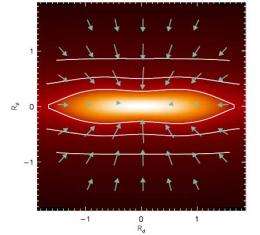Making massive stars

Massive stars -- those with more than about eight times the mass of the sun -- are arguably the most important actors in the universe. Much hotter and more luminous than the sun, they live only hundreds of millions of years before exploding in supernovae, but during their lives their nuclear furnaces produce a wide range of chemical elements (the universe was created with primarily hydrogen and helium).
Meanwhile they heat up their galactic neighborhoods and dominate the properties of their environments and their gas and dust. In their dramatic deaths they seed the universe with these elements (and others produced in the cataclysm), disrupt their neighborhoods, and leave behind neutron stars or sometimes black holes.
Massive stars are much less common than sun-sized stars, comprising only a few tenths of a percent of all stars, and astronomers wonder why. It is not clear if standard ideas about star formation apply to massive stars. For example, do they grow like smaller stars by accreting material from a large envelope while also surrounded by a rotating disk of material?
Massive stars mature very quickly, however, in less than a few hundred thousand years compared with millions of years for stars like the sun, and as a result there are not many young ones around at any given time in which to study the processes associated with their birth.
Two SAO astronomers, Eric Keto and Qizhou Zhang, argue in a new paper that massive stars do form like smaller ones, at least with respect to their envelopes and disks. Combining observations of molecular gas in one young, massive star with computer models of star formation that were scaled up to fit this more massive case, they find very good agreement, at least with stars of masses up to ten solar masses (stars more massive than this may yet have differences).
The results not only suggest that theorists are on the right track, they imply that future observations of massive young stars with new instruments can expect to see the signatures of these disks in their data.
Provided by Harvard-Smithsonian Center for Astrophysics




















